CRANIUM PIE
INTERSTELLAR OVERPIE
di Giampiero Fleba
I hit the ground
Spinning light signal now
Skies are clear
and the time is near
Take a trip to the Mothership somehow
Plenirockium ancora sulle tracce di una magnifica band della playlist 2015 per offrirvi questa intervista esclusiva ai Cranium Pie, quintetto originario dell’Hertfordshire attivo dalla metà dei 2000 e tra i più creativi nel panorama underground contemporaneo. Tim Bray (tastiere, voce), Rob Appleton (tastiere), Julian ‘Smithy’ Smith (batteria), Dan ‘Dendrix’ Herra (chitarra) e Steve Meadows (basso) suonano una folle astronomia rock e possono essere seguiti anche a testa in giù nell’assenza di gravità generata da polifonie stellari su confluenze space-psych-jazz-prog-folk. Una storia che va raccontata dall’inizio nel giocoso conversare con i due maghi delle tastiere Tim Bray e Rob Appleton…
Tim – Cranium Pie nacquero originariamente come nome per una band immaginaria degli anni ’70 di cui avevamo scoperto i nastri in una soffitta dei nostri nonni. In seguito avremmo realizzato quelle registrazioni su vinile annunciando una band davvero sorprendente degli 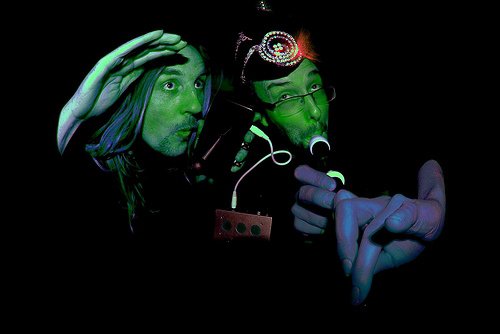 anni ’70 di cui nessuno aveva mai sentito parlare. E ‘stata una parodia che ci è sfuggita di mano. Un amico di Smithy aveva già iniziato l’antefatto con una falsa serie televisiva degli anni ’60 chiamata ‘Charlie Why’, penso fosse un detective paranormale. Tracciò alcuni dettagli sui personaggi delineando la trama, i titoli degli episodi e lo schema mentre Rob e Smithy avrebbero registrato la colonna sonora e altre tracce per accompagnare la serie (‘Tears of a Clone’ è uno dei titoli che mi sono rimasti impressi). Questo finì tutto su internet ad un certo punto, ma è lontano nel tempo, introvabile ora. Così, la colonna sonora della serie è stata fatta da un trio immaginario conosciuto come The Triplet: Rob, Smithy e uno dei loro amici Jules. Il nome immaginario di Rob era Reg Crane e a un certo punto lungo gli
anni ’70 di cui nessuno aveva mai sentito parlare. E ‘stata una parodia che ci è sfuggita di mano. Un amico di Smithy aveva già iniziato l’antefatto con una falsa serie televisiva degli anni ’60 chiamata ‘Charlie Why’, penso fosse un detective paranormale. Tracciò alcuni dettagli sui personaggi delineando la trama, i titoli degli episodi e lo schema mentre Rob e Smithy avrebbero registrato la colonna sonora e altre tracce per accompagnare la serie (‘Tears of a Clone’ è uno dei titoli che mi sono rimasti impressi). Questo finì tutto su internet ad un certo punto, ma è lontano nel tempo, introvabile ora. Così, la colonna sonora della serie è stata fatta da un trio immaginario conosciuto come The Triplet: Rob, Smithy e uno dei loro amici Jules. Il nome immaginario di Rob era Reg Crane e a un certo punto lungo gli eventi arrivai io chiamandomi Mike Pye. In realtà poi ci fu una vera collaborazione e mantennemmo i nomi di fantasia per formare il nuovo progetto Cranium Pie e questo è tutto. La band inesistente fu così fondata e i nastri sono ancora in attesa di scoperta nella soffitta immaginaria dei nonni di qualcuno a Watford.
eventi arrivai io chiamandomi Mike Pye. In realtà poi ci fu una vera collaborazione e mantennemmo i nomi di fantasia per formare il nuovo progetto Cranium Pie e questo è tutto. La band inesistente fu così fondata e i nastri sono ancora in attesa di scoperta nella soffitta immaginaria dei nonni di qualcuno a Watford.
Rob – Sì, è stato uno strano modo di formare una band. Siamo stati tutti in altre bands, Smithy ed io suoniamo insieme e altrove da circa 25 anni, abbiamo un collegamento quasi psichico quando si tratta di suonare, mai provato la stessa sensazione con altri. Dendrix e le sue chitarre sono ben noti a Bath, ha suonato (e senza dubbio ripudiato) in decine di band. Eravamo gli unici rimasti abbastanza coraggiosi da prenderlo – molte persone non potevano credere che l’avremmo fatto – ma in qualche modo la musica lo ha domato, o qualcosa del genere (beh, ci sono stati momenti di ricaduta naturalmente, di solito in pubblico). Tim e io eravamo in un gruppo di improvvisazione, Space Junk Triangle, e anche Steve è stato intorno a varie sembianze per anni. Siamo stabili? Considerando tutto il danno cerebrale collettivo che la band ha condiviso, non siamo andati male.
Nel 2008 alcune vostre canzoni vengono pubblicate nei due volumi iniziali del progetto enciclopedico di Amorphous Androgynous (aka The Future Sound of London) ‘A Monstrous Psychedelic Bubble’: ‘Vol 1 – Cosmic Space Music’ e ‘Vol 2 – Pagan Love Vibrations’. Sono state anche le vostre prime incisioni? Come è nato l’incontro con Brian Dougans e Garry Cobain e quanto ha contribuito a farvi conoscere la vostra presenza in queste compilations?
 Rob – Si, la traccia su Bubble 1 veniva da “The Geometry of Thistles” mentre su Bubble 2 era un estratto di ‘Madman Running Through the Fields’ (versione completa sul singolo Fruits de Mer). Conobbi Gaz attraverso Myspace poi fuori dal cyberspazio nel loro “Monstrous Bubble Extravaganza” al Green Man Festival dove ci invitarono per aprire un set psichedelico di 11 ore che comprendeva Hawkwind, Amorphous Androgynous e Nick Nicely. Questo fu il primo vero concerto dei Cranium Pie, avevamo provato la settimana prima al pub del mio villaggio e la gente non sapeva bene come ma sembrava avessero gradito. Le apparizioni sulle Bubble compilations
Rob – Si, la traccia su Bubble 1 veniva da “The Geometry of Thistles” mentre su Bubble 2 era un estratto di ‘Madman Running Through the Fields’ (versione completa sul singolo Fruits de Mer). Conobbi Gaz attraverso Myspace poi fuori dal cyberspazio nel loro “Monstrous Bubble Extravaganza” al Green Man Festival dove ci invitarono per aprire un set psichedelico di 11 ore che comprendeva Hawkwind, Amorphous Androgynous e Nick Nicely. Questo fu il primo vero concerto dei Cranium Pie, avevamo provato la settimana prima al pub del mio villaggio e la gente non sapeva bene come ma sembrava avessero gradito. Le apparizioni sulle Bubble compilations 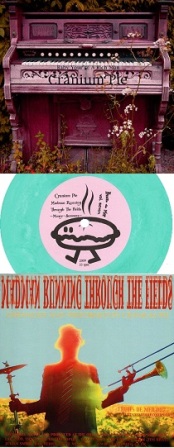 possono aver contribuito a promuoverci, ma poi abbiamo sempre finito per naufragare via di nuovo nel nostro nascondiglio sotterraneo, quindi è tutto relativo alla fine. La maggior parte deI nostri dischi sono venduti grazie al lavoro instancabile di Fruits de Mer, la grande pescheria di Keith Jones ed anche dall’interesse dei collezionisti su ebay.
possono aver contribuito a promuoverci, ma poi abbiamo sempre finito per naufragare via di nuovo nel nostro nascondiglio sotterraneo, quindi è tutto relativo alla fine. La maggior parte deI nostri dischi sono venduti grazie al lavoro instancabile di Fruits de Mer, la grande pescheria di Keith Jones ed anche dall’interesse dei collezionisti su ebay.
La favolosa cover di ‘Madman Running Through The Fields’ dei Dantalian’s Chariots, e una versione di ‘Baby You’re A Rich Man’ dei Beatles sono anche sul vostro singolo 7″ di debutto realizzato da Fruits de Mer nel 2009 in una ‘collana’ di tributi alla galassia underground planetaria anni 60 – 70 tuttora in corso ed inizio anche del vostro rapporto con con l’etichetta di Walton on Thames. Come è nato questo rapporto e la scelta di omaggiare quelle due canzoni?
Tim – Smithy venne allo studio di Rob con l’idea di fare una versione leggera di ‘Baby You’re a Rich Man’ registrata nell’Organarium, uno studio prove che avevamo affittato e riempito con parecchie tastiere, pianoforti, organi, manichini, chitarre, tre batterie, numerosi amplificatori, buffe parrucche, divani, televisori rotti, in pratica tutto e niente. Quella registrazione venne postata su Youtube e Myspace diventando il primo incontro con la Fruits de Mer di Keith Jones (e Andy Bracken). Apprezzò e ci chiese altri brani. Non sapeva a cosa andava incontro, mi chiedo col senno di poi se lo farebbe ancora.
Nel 2010 esce il vostro secondo singolo “Mothership / Rememberrr” su Bracken, due composizioni originali e per noi 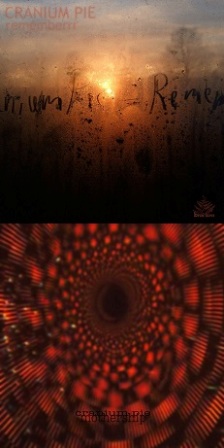 tra i 7″ più belli degli anni 2000. Credo l’ultimo realizzato dall’etichetta che aveva precorso Fruits de Mer. Due corpi spaziali fluttuanti in un cosmo di tastiere e sintetizzatori dove sviluppate la vostra idea di psychedelia progressiva anche come tendenza al futuro nell’esprimere una musica di ricerca e contaminazione. Cosa vi ha ispirato a svilupparla?
tra i 7″ più belli degli anni 2000. Credo l’ultimo realizzato dall’etichetta che aveva precorso Fruits de Mer. Due corpi spaziali fluttuanti in un cosmo di tastiere e sintetizzatori dove sviluppate la vostra idea di psychedelia progressiva anche come tendenza al futuro nell’esprimere una musica di ricerca e contaminazione. Cosa vi ha ispirato a svilupparla?
Rob – Non saprei, forse molti anni di ascolto di buona musica impregnati nella nostra psiche, alcuni aspetti dei dischi sono bene impressi nel mio cervello, come la miscela di chitarra acustica e synths in “Animals” dei Pink Floyd, davvero un grande album. Smithy ed io collezioniamo dischi da quando eravamo adolescenti e da tanti anni condividiamo le nuove scoperte. Un nostro amico mi ha fatto conoscere ogni sorta di rarità psichedelica e progressive al punto da farmi sembrare naturale una loro fusione, un pò come avere la visione di fare il tipo di musica che volevo ascoltare. ‘Rememberrr’ fu sviluppata dalla versione originale di “The Geometry of Thistles”.
Curiosità, perchè 3 ‘r’ in ‘Rememberrr’?
Rob – Avevamo usato parecchio effetto eco sulle voci così ci sembrava sensato usare l’eco anche nel titolo.
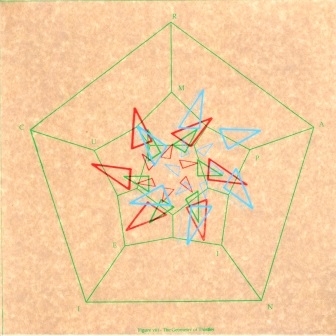 “The Geometry of Thistles” esce nel 2012 (LP & CD) autoprodotto su Lunartica ma appartiene ai vostri esordi come band, dalle note interne testimonia un periodo compreso tra il 2006 e il 2010. Parlateci di questo bellissimo album, in cui prevale una componente acustica nel quadro di incantevoli geometrie folk psichedeliche, in pratica il vostro ‘John Barleycorn’…
“The Geometry of Thistles” esce nel 2012 (LP & CD) autoprodotto su Lunartica ma appartiene ai vostri esordi come band, dalle note interne testimonia un periodo compreso tra il 2006 e il 2010. Parlateci di questo bellissimo album, in cui prevale una componente acustica nel quadro di incantevoli geometrie folk psichedeliche, in pratica il vostro ‘John Barleycorn’…
Tim – Questo è stato il risultato di molte discussioni mentre con Rob stavamo costruendo muretti a secco in campagna sotto il sole autunnale. Alla fine ci è capitato di registrare. All’esterno, in cucina, davvero ovunque. E ‘stata una psichedelia molto giocosa e senza alcun reale desiderio di essere qualcosa in particolare, un suono originale che solo io e Rob sappiamo davvero maneggiare. Questo avvenne prima che i Future Sound Of London ci contattassero e ci offrissero di suonare dal vivo. Mi  sarebbe piaciuto mantenere questa atmosfera, ma non siamo riusciti a capire come avremmo potuto ottenerla sul palco di un festival. Abbiamo pensato che ci serviva un suono più esteso quindi abbiamo reclutato Dan e Steve. Smithy aveva alcune parti su Geometry. ‘Trawler Man’ e ‘Animals and Wood’ sono sue. Abbiamo cercato di tornare al folk un paio di volte, ma in realtà quello fu il momento. Non potevamo davvero riconquistare l’innocenza e la magia degli esordi.
sarebbe piaciuto mantenere questa atmosfera, ma non siamo riusciti a capire come avremmo potuto ottenerla sul palco di un festival. Abbiamo pensato che ci serviva un suono più esteso quindi abbiamo reclutato Dan e Steve. Smithy aveva alcune parti su Geometry. ‘Trawler Man’ e ‘Animals and Wood’ sono sue. Abbiamo cercato di tornare al folk un paio di volte, ma in realtà quello fu il momento. Non potevamo davvero riconquistare l’innocenza e la magia degli esordi.
Rob – Si, i primi giorni dei Pie furono molto diversi e in realtà più sperimentali credo. Alcune ispirazioni per me includevano la Incredible String Band, Syd Barrett, i muretti a secco della tenuta di Mr Fuller a Little Chalfield, la cucina arancione di Tim, un tempo di innocenza con le nubi scure all’orizzonte. Non ero molto sveglio allora (anche se ovviamente pensavo di esserlo) quindi credo che spiegherebbe la mia parte sognante nel tutto, molto è cambiato così almeno per me, credo che quella fase rimarrà sempre nel passato.
Nel 2011 esce “Mechanisms Part 1”, un progetto potente svelato da alchimie acustiche-elettriche-elettroniche. Ci raccontate come è nato questo album e a chi si ispira musicalmente?
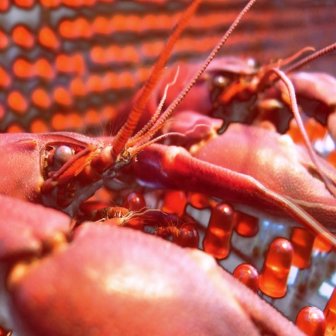 Rob – Influenze musicali potrebbero essere artisti come Arthur Brown, Pink Floyd ovviamente, Frank Zappa, la scena di Canterbury tutta quanta davvero. L’intero lavoro è stato registrato nel mio vecchio studio-capannone nel sud ovest dell’Inghilterra, idee frullate da molte notti in bianco, poi mesi cercando di decifrare tutta la follia e farne un album. Nessuno sapeva come sarebbe andata a finire, o che cosa realmente fosse anche mentre era in corso, nessuna traccia mai suonata allo stesso modo ogni volta che abbiamo provato, tanta improvvisazione è diventata la nostra musica. Naturalmente parecchio del nostro suono si riduce alla combinazione di tutti i nostri stili, ad esempio Dan ha questo modo soul davvero tagliente, aggressivo di suonare la chitarra, è unico per lui e incredibile, veramente ti colpisce, penso che sia un genio totale effettivamente. Il drumming di Smithy è spesso ispirato dal Jazz britannico a partire dai primi anni ’70 da gruppi come Nucleus. Tim si ispira … beh … em … meglio non andarci … ma quando tutto viene mescolato insieme diventa questo amalgama che siamo ‘noi’ suppongo.
Rob – Influenze musicali potrebbero essere artisti come Arthur Brown, Pink Floyd ovviamente, Frank Zappa, la scena di Canterbury tutta quanta davvero. L’intero lavoro è stato registrato nel mio vecchio studio-capannone nel sud ovest dell’Inghilterra, idee frullate da molte notti in bianco, poi mesi cercando di decifrare tutta la follia e farne un album. Nessuno sapeva come sarebbe andata a finire, o che cosa realmente fosse anche mentre era in corso, nessuna traccia mai suonata allo stesso modo ogni volta che abbiamo provato, tanta improvvisazione è diventata la nostra musica. Naturalmente parecchio del nostro suono si riduce alla combinazione di tutti i nostri stili, ad esempio Dan ha questo modo soul davvero tagliente, aggressivo di suonare la chitarra, è unico per lui e incredibile, veramente ti colpisce, penso che sia un genio totale effettivamente. Il drumming di Smithy è spesso ispirato dal Jazz britannico a partire dai primi anni ’70 da gruppi come Nucleus. Tim si ispira … beh … em … meglio non andarci … ma quando tutto viene mescolato insieme diventa questo amalgama che siamo ‘noi’ suppongo.
“Mechanisms Part 1” è un grande crogiolo dove space rock, jazz, psychedelia e progressive frullano a 360° attivati da 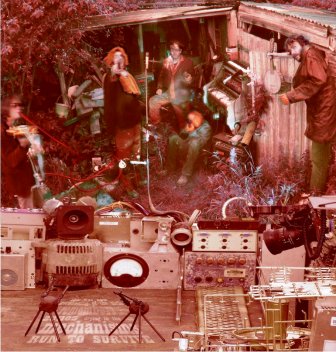 una pensiero corrosivo e scherzoso, una ricerca del paradossale, un’attenzione critica alla società su problematiche ambientali, tecnologiche e di alienazione che produce spunti di riflessione. Meccanismi, macchine e strane creature simili a crostacei. Ce ne potete parlare?
una pensiero corrosivo e scherzoso, una ricerca del paradossale, un’attenzione critica alla società su problematiche ambientali, tecnologiche e di alienazione che produce spunti di riflessione. Meccanismi, macchine e strane creature simili a crostacei. Ce ne potete parlare?
Tim – Abbiamo avuto questa vaga idea nel momento in cui tutto correva verso la fine del mondo. Il calendario Maya stava volgendo al termine, ci sono stati racconti dello slittamento polare, il disastroso sversamento di petrolio dalla piattaforma Deepwater Horizon fu rapidamente nelle cronache e noi avevamo la sensazione che ci mentono su ogni cosa. Se sentivamo che il nostro mondo si stava dirigendo verso la sua fine, come sarebbe stata l’ultima band rimasta per raccontare la storia o il capitolo finale della nostra civiltà? Inoltre nello stesso periodo saccheggi di massa e scontri scoppiavano a Londra ed è stato un momento di vittime e disordini civili in tutta l’Inghilterra. Alcuni erano solo idioti che saccheggiavano negozi schifosi per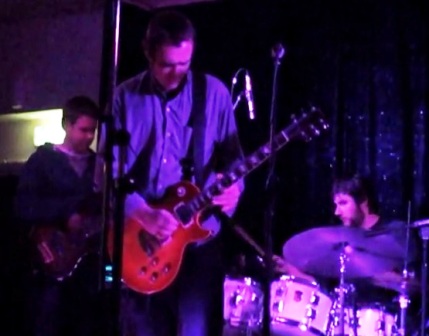 rubare vestiti e prodotti elettrici. Ma è stato spaventoso. Immaginate se queste folle in tumulto avessero avuto fame e saccheggiavano case alla ricerca di beni essenziali. Sembrava l’inizio dei giorni finali. A Rob venne in mente anche questo tema fuori di testa, in parte a causa della grande quantità di gamberi che vide in un ruscello vicino a casa. Sono Signal crayfish, gamberi americani e hanno decimato i gamberi d’acqua dolce nativi europei (Austropotamobius pallipes). Avevamo spunti musicali e storie da seguire in una sorta di linea temporale. Solo il racconto è cambiato costantemente durante il percorso diventando sempre più complicato, con numerosi colpi di scena che ci lasciavano tutti completamente disorientati rispetto a ciò che era all’inizio. Abbiamo registrato molto materiale come un gioco pur avendo questa storia pazzesca che poteva andare dove volevamo e se un’idea pure stupida o
rubare vestiti e prodotti elettrici. Ma è stato spaventoso. Immaginate se queste folle in tumulto avessero avuto fame e saccheggiavano case alla ricerca di beni essenziali. Sembrava l’inizio dei giorni finali. A Rob venne in mente anche questo tema fuori di testa, in parte a causa della grande quantità di gamberi che vide in un ruscello vicino a casa. Sono Signal crayfish, gamberi americani e hanno decimato i gamberi d’acqua dolce nativi europei (Austropotamobius pallipes). Avevamo spunti musicali e storie da seguire in una sorta di linea temporale. Solo il racconto è cambiato costantemente durante il percorso diventando sempre più complicato, con numerosi colpi di scena che ci lasciavano tutti completamente disorientati rispetto a ciò che era all’inizio. Abbiamo registrato molto materiale come un gioco pur avendo questa storia pazzesca che poteva andare dove volevamo e se un’idea pure stupida o  folle che fosse era anche divertente, veniva considerata. A tutti noi piacciono le cose strane e bizzarre e abbiamo un simile senso dell’umorismo, così una storia seria narrata o musicale avrà sempre a che fare con un po’ di qualcosa che ci fa divertire allo stesso tempo, forse qualcosa delle varie battute che si insinua nelle nostre menti infantili sensibili alle stronzate oppure la registrazione della pernacchietta in sottofondo che solo noi otteniamo o sappiamo che c’è.
folle che fosse era anche divertente, veniva considerata. A tutti noi piacciono le cose strane e bizzarre e abbiamo un simile senso dell’umorismo, così una storia seria narrata o musicale avrà sempre a che fare con un po’ di qualcosa che ci fa divertire allo stesso tempo, forse qualcosa delle varie battute che si insinua nelle nostre menti infantili sensibili alle stronzate oppure la registrazione della pernacchietta in sottofondo che solo noi otteniamo o sappiamo che c’è.
Rob – Essenzialmente dentro gli album dei ‘Mechanisms’ ci sono elementi di serietà rivestiti di humour. Credo che l’umorismo sia lo strumento più prezioso di cui abbiamo bisogno se la merda colpisce davvero il ventilatore. Gli album sono in ultima analisi, una reazione alla follia della società autoritaria dove i meccanismi cercano di sconfiggerci. Suppongo che il messaggio sarebbe per noi di svegliarci e non accettare questo conformismo volontario di cui risentono la maggior parte degli esseri umani. Credo che il ridicolo nel concetto di meccanizzazione è un riflesso di come abbiamo formato il nostro mondo e il modo in cui abbiamo vincolato le nostre vite attraverso la paura e la mancanza di immaginazione. E’ come essere assuefatti a questo tipo di normalità e non essere in grado di rompere l’abitudine, sempre di rimando con quelli a destra e a sinistra di noi per assicurarsi di non distinguersi troppo da loro. È tutto così noioso e prevedibile. Credo che questo sia ciò da cui stiamo cercando di sfuggire con la nostra musica.
E’ interessante come la vostra ricerca musicale sviluppi anche una ‘meccanica’ fantascientifica, le voci sono spesso 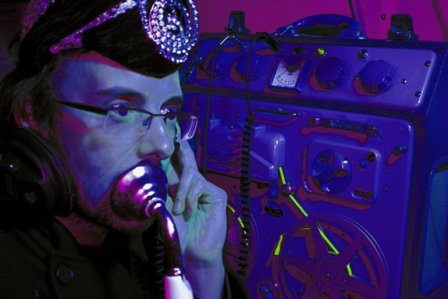 trattate e de-umanizzate e la trasmissione del vostro suono è come un moto caratterizzato da livelli di potenza e velocità in ritmi complessi su cui dialogano chitarra e tastiere. Inoltre le tastiere sono rilevanti anche in funzione di meccanismi che generano suoni, che tipo di strumentazione elettronica suonate? Lavorate anche sui campionamenti e sulla manipolazione dei nastri?
trattate e de-umanizzate e la trasmissione del vostro suono è come un moto caratterizzato da livelli di potenza e velocità in ritmi complessi su cui dialogano chitarra e tastiere. Inoltre le tastiere sono rilevanti anche in funzione di meccanismi che generano suoni, che tipo di strumentazione elettronica suonate? Lavorate anche sui campionamenti e sulla manipolazione dei nastri?
Tim – Dal punto di vista delle parti vocali, questa è sempre stata una specie di area difficoltosa. Nessuno di noi aveva una voce particolarmente potente o intonata. Rob ha sperimentato vari trucchi per aggirare questo aspetto. Spesso la voce viene registrata più volte per formare il ‘Pie Choir’ o convogliandone metà attraverso i ring modulators, i delays o i distorsori. Giusto per giocare con i suoni alla ricerca di qualcosa fino a quel momento inaspettata ma che funziona bene. Per ogni band l’incidente felice è un evento comune nella tecnica di 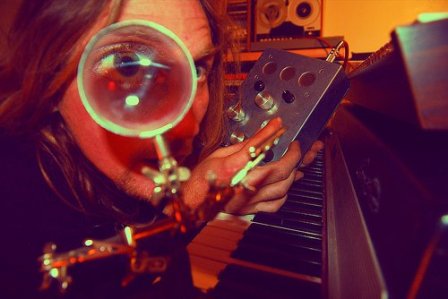 registrazione. Mantenendoci sul tema dei mechanoids e dei suoni ipotetici dei gamberi di fiume se fossero stati in grado di generare qualcosa di udibile, cosa avrebbero prodotto?
registrazione. Mantenendoci sul tema dei mechanoids e dei suoni ipotetici dei gamberi di fiume se fossero stati in grado di generare qualcosa di udibile, cosa avrebbero prodotto?
Rob – La maggior parte delle tastiere è chincaglieria analogica come il Logan String Melody, il Roland Juno 60, uso anche un Hammond M100 e un Fender Rhodes. Ho fatto campionare da amici Mellotron e Minimoog e usato anche alcuni di questi suoni. Uno dei miei campionamenti preferiti è su “Geometry of Thistles” all’inizio di ‘Awakening of the Birds’. C’erano un paio di amici di Tim e uno di loro ha suggerito di sfogliare libri velocemente per simulare le ali degli uccelli, così noi tutti in fila con un libro da sbattere per simulare gli uccelli che volano via. Avere questo tipo di libertà creativa nella musica, dove tutto è permesso, sembra avere senso per noi.
Rob, parlando di elettronica sul vostro sito Bandcamp hai pubblicato Moonweevil, un tuo progetto del 2006 intitolato “A Peculiar Accumulation Of Particles”, molto kosmische e descritto come ‘rural Electronica and Train Journey Soundtracks’. Ce ne puoi parlare?
Rob – E’ stato una specie di flusso di inconsapevole insieme elettronico che ho fatto prima di Cranium Pie, suscettibile di interpretazione davvero. Ho voluto creare un po’ di elettronica non-urbana, non-modaiola per ispirare una condizione onirica. Funziona bene con le cuffie quando stai osservando creazioni dell’uomo attraverso il finestrino di un treno o giù di lì. Attualmente sto lavorando ad un nuovo Moonweevil (credo).
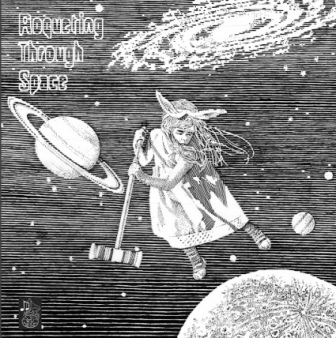 A proposito di progetti extra-Cranium Pie, nel 2011 Fruits de Mer pubblica le compilations ‘Roqueting Through Space’ e ‘Keep off the Grass’ in cui apparite con il nome di Cranium Pie’s Baking Research Station per reinterpretare ‘Blacksand’ dei pionieri spacerockers Brainticket e ‘Welcome to the Citadel’ di Mark Brierley (anche titolo del suo primo album) da cui elaborate una base folk psichedelica in 10 minuti di spazio siderale jazz-prog. Recentemente ancora in un progetto di Amorphous Androgynous su “The Cartel Remixes” rivisitazione di ‘The Cartel’, uno studio psichedelico sulle colonne sonore dei film blaxploitation anni 70. In definitiva Cranium Pie’s Baking Research Station è un gruppo parallelo che potrebbe avere un futuro? Dalle note sui vostri dischi Baking Research Station è spesso citata anche come il vostro studio. Ci raccontate qualcosa?
A proposito di progetti extra-Cranium Pie, nel 2011 Fruits de Mer pubblica le compilations ‘Roqueting Through Space’ e ‘Keep off the Grass’ in cui apparite con il nome di Cranium Pie’s Baking Research Station per reinterpretare ‘Blacksand’ dei pionieri spacerockers Brainticket e ‘Welcome to the Citadel’ di Mark Brierley (anche titolo del suo primo album) da cui elaborate una base folk psichedelica in 10 minuti di spazio siderale jazz-prog. Recentemente ancora in un progetto di Amorphous Androgynous su “The Cartel Remixes” rivisitazione di ‘The Cartel’, uno studio psichedelico sulle colonne sonore dei film blaxploitation anni 70. In definitiva Cranium Pie’s Baking Research Station è un gruppo parallelo che potrebbe avere un futuro? Dalle note sui vostri dischi Baking Research Station è spesso citata anche come il vostro studio. Ci raccontate qualcosa?
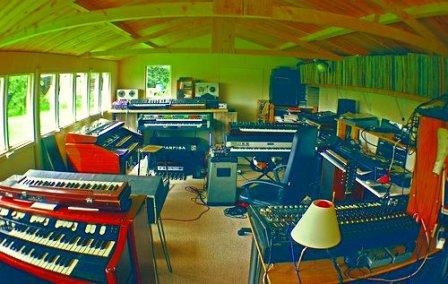
Rob – The Baking Research Station era un centro di ricerca sulla produzione del pane di fronte alla mia vecchia scuola elementare in Chorleywood e divenne il nome del mio studio capannone. Al momento non ho nessun studio dato che mi sono stabilito nelle Alpi ma ci sto lavorando nella speranza di una riunione estiva dei Cranium Pie qui in Austria. E’anche il nome per progetti collaterali legati ai Pie, per lo più produzioni basate su tracce che di registrazioni della band.
Nel 2012, Cranium Pie e The Baking Research Station sono ancora insieme in un 7″ con le covers di “A Visit To Newport Hospital / Queen Street Gang” rispettivamente di Egg e Arzachel, leggendarie formazioni con il grande tastierista Dave Stewart e vostro personale omaggio alla musica di Canterbury (penso anche 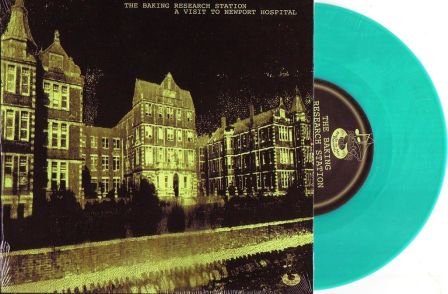 alla copertina del primo Soft Machine con i meccanismi e a similitudini con le vostre idee che fondono in un tutt’uno il nonsenso, l’ironia e l’assurdo). E’ quasi un’ispirazione costante da cui traspare la vostra passione per questa scena fondamentale che può ancora influire su nuove generazioni di musicisti. Siete d’accordo?
alla copertina del primo Soft Machine con i meccanismi e a similitudini con le vostre idee che fondono in un tutt’uno il nonsenso, l’ironia e l’assurdo). E’ quasi un’ispirazione costante da cui traspare la vostra passione per questa scena fondamentale che può ancora influire su nuove generazioni di musicisti. Siete d’accordo?
Tim – Per me è stata una scusa per vestirsi da Penny Handy, la parte femminile della mia personalità, e mettere in atto una seduta spiritica. Abbiamo trascorso parecchio tempo per il video su Youtube cercando di perfezionare l’effetto di ectoplasma versato dalla mia bocca con strisce di cotone bianco poi non incluso nel video.
Rob – Shit! Non farmi ricordare quella sera e le riprese della seduta, è stata una delle più divertenti ed anche più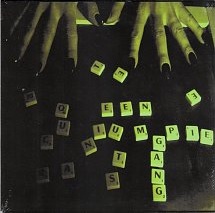 inquietanti notti della mia vita – Tim ha un talento speciale per divertirsi ma inquietante, dovrebbe avere il suo show televisivo. Un giorno recupererò i video out-take e li pubblicherò su YouTube, ho solo bisogno di un paio di anni per elaborare quella serata fatidica e rivisitare il filmato.
inquietanti notti della mia vita – Tim ha un talento speciale per divertirsi ma inquietante, dovrebbe avere il suo show televisivo. Un giorno recupererò i video out-take e li pubblicherò su YouTube, ho solo bisogno di un paio di anni per elaborare quella serata fatidica e rivisitare il filmato.
C’è qualcosa di molto speciale nella scena di Canterbury, i musicisti erano semplicemente incredibili, una fantastica fusione prog-psych-jazz. Più ci penso e più mi deprimo sul fatto che forse non ci sarà mai un altro periodo di musica come quello di fine anni ’60 / primi anni ’70, è incredibile come ci fosse in giro così tanto talento e buon gusto, inoltre molte delle migliori band erano in quella scena per motivi diversi, forse questo fa parte del segreto della loro magia.
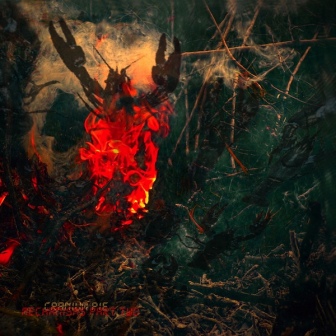 Il terzo album è storia recentissima a consolidamento del rapporto con Fruits de Mer pubblicato nel Marzo 2015. “Mechanisms Part Two”, secondo capitolo nel mondo dei Meccanismi esposto in un doppio vinile: disco 1 ‘We are not Human’ e disco 2 ‘We are not Machines’. Un manifesto space rock moderno!! Le note di copertina rivelano il nuovo contesto fantascentifico tra scenari post apocalittici e macchine del tempo. Tre anni per generare i nuovi ‘meccanismi’, ci raccontate qualcosa di questa gestazione?
Il terzo album è storia recentissima a consolidamento del rapporto con Fruits de Mer pubblicato nel Marzo 2015. “Mechanisms Part Two”, secondo capitolo nel mondo dei Meccanismi esposto in un doppio vinile: disco 1 ‘We are not Human’ e disco 2 ‘We are not Machines’. Un manifesto space rock moderno!! Le note di copertina rivelano il nuovo contesto fantascentifico tra scenari post apocalittici e macchine del tempo. Tre anni per generare i nuovi ‘meccanismi’, ci raccontate qualcosa di questa gestazione?
Tim – E’ tutto parte di un sogno strano a ripensarci. Sembrava quasi impossibile con quello che stava succedendo. Dan era costantemente fuori dai binari, Steve era abbastanza distaccato, occupato a fare concerti itineranti e cercando di mantenere la propria vita in pista. Smithy ne aveva avuto praticamente abbastanza di tutta la faccenda e stava cercando di avviare il suo nuovo negozio di dischi Second Scene. E credo che ciò si concluse per friggerci il cervello e ad essere onesti rendere sempre più difficile entrare tutti in un unico luogo, allo stesso tempo. Suonai per un po’ la batteria dopo alcuni provini a un paio di altri batteristi mentre Rob era preso con i suoi piani e alla fine si trasferì in Austria. Ma basta ascoltare i ‘Mechanisms Tapes’ per avere 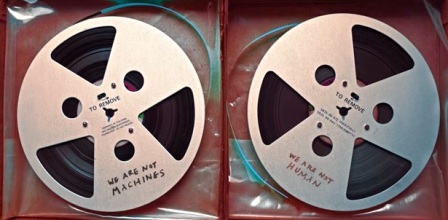 l’impressione di quanta roba avevamo registrato, inoltre Rob ha un tecnica di archiviazione un po’ casuale e ciò vuol dire che se qualcosa è stato trovato ha del miracoloso. Naturalmente ci deve essere stato un metodo perchè alla fine lo ha fatto. Si trasferisce in Austria e in qualche modo seleziona il groviglio senza fine e crea un prodotto finale di cui non siamo stati solo stupiti ma davvero orgogliosi. Deduco che differisca completamente dalla registrazione del ‘White Album’ dei Beatles, ma ho la sensazione ci siano alcune somiglianze anche se con noi non c’era Yoko.
l’impressione di quanta roba avevamo registrato, inoltre Rob ha un tecnica di archiviazione un po’ casuale e ciò vuol dire che se qualcosa è stato trovato ha del miracoloso. Naturalmente ci deve essere stato un metodo perchè alla fine lo ha fatto. Si trasferisce in Austria e in qualche modo seleziona il groviglio senza fine e crea un prodotto finale di cui non siamo stati solo stupiti ma davvero orgogliosi. Deduco che differisca completamente dalla registrazione del ‘White Album’ dei Beatles, ma ho la sensazione ci siano alcune somiglianze anche se con noi non c’era Yoko.
Rob – E ‘stato un compito epico in realtà, Tim ha sintetizzato bene ma per aggiungere un po’ è iniziato con buone intenzioni: scrivendo tracce, convincendo Dandrix di venire e fare le sue parti di chitarra o Smithy di definire le percussioni. Allora finimmo per concludere con una enormità di prove e materiale ma mai 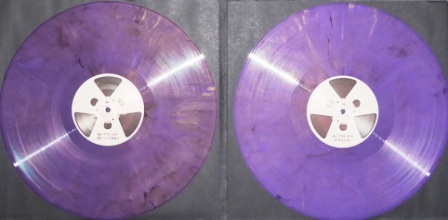 effettivamente terminato. Poi mi sono trasferito all’estero e ho trascorso un anno a raffinare il mostruoso tumulo onnipotente in qualcosa che avesse la forma di un album solo che questo mostro era così grande che doveva essere un doppio LP. E poi c’erano ancora mostruosità rimaste per fare un triplo – The Mechanisms Tapes – che in realtà contiene parte del nostro miglior materiale dalle linee un po’ grezze ma offre una vera idea di ciò che stavamo facendo. Alcune delle nostre jam erano veramente incredibili, a volte non riuscivamo a credere a quello che stava succedendo, c’è stata una vera magia in quel capannone in particolare con una specie di suono fondente e vibrante. Ora la mia missione è quella di costruire un nuovo studio in montagna quindi trascinare i degenerati attraverso il canale e in qualche modo iniziare a suonare di nuovo.
effettivamente terminato. Poi mi sono trasferito all’estero e ho trascorso un anno a raffinare il mostruoso tumulo onnipotente in qualcosa che avesse la forma di un album solo che questo mostro era così grande che doveva essere un doppio LP. E poi c’erano ancora mostruosità rimaste per fare un triplo – The Mechanisms Tapes – che in realtà contiene parte del nostro miglior materiale dalle linee un po’ grezze ma offre una vera idea di ciò che stavamo facendo. Alcune delle nostre jam erano veramente incredibili, a volte non riuscivamo a credere a quello che stava succedendo, c’è stata una vera magia in quel capannone in particolare con una specie di suono fondente e vibrante. Ora la mia missione è quella di costruire un nuovo studio in montagna quindi trascinare i degenerati attraverso il canale e in qualche modo iniziare a suonare di nuovo.
Meccanismi anche come parte di sistemi articolati per la costruzione di 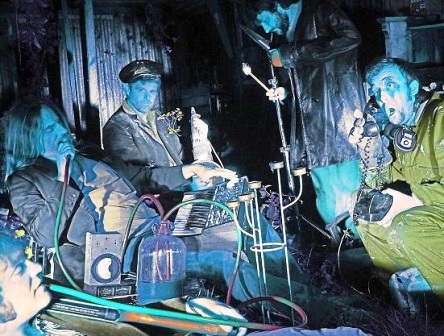 macchine automatiche in grado di realizzare movimenti complessi e di assolvere a funzioni umane: i robot, un tema molto attuale spesso anticipato dai grandi scrittori di fantascienza come Isaac Asimov e Philip K. Dick. Uomini e macchine, intelligenza artificiale, illusione di libertà, lavoratori dequalificati, armi e de-evoluzione. Ancora una volta l’uomo nel tentativo di migliorare la propria vita rischia di complicarsela. Infatti nella vostra storia, l’umanità è già estinta: nessuna speranza allora?
macchine automatiche in grado di realizzare movimenti complessi e di assolvere a funzioni umane: i robot, un tema molto attuale spesso anticipato dai grandi scrittori di fantascienza come Isaac Asimov e Philip K. Dick. Uomini e macchine, intelligenza artificiale, illusione di libertà, lavoratori dequalificati, armi e de-evoluzione. Ancora una volta l’uomo nel tentativo di migliorare la propria vita rischia di complicarsela. Infatti nella vostra storia, l’umanità è già estinta: nessuna speranza allora?
Tim – Forse no. Ma penso che i Crayfish finiscono per costruire l’omuncolo e quindi c’è speranza perchè ha funzionato e questo abominio sfigurato vagamente simile ad una forma umana va avanti per aiutare a sconfiggere i meccanismi. Egli intravede il battito di ciglia di un vagabondo che stava sbirciando attraverso un buco nel muro per osservare tutta la fine 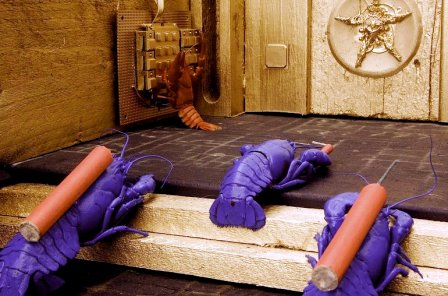 della civiltà e succedeva come guardare il telegiornale. Impotente e aggiornato su ogni schifezza messa sullo schermo, il vagabondo era beatamente residente nella 11a Dimensione. Questo è un luogo dove tutto finisce. Il prossimo album possibilmente. Speriamo di riuscire a farlo da remoto. Rob farà la testa e la invierà a me. Io farò il corpo per rispedirlo a Rob che farà le gambe e lo rinvia a me per aggiungere i piedi. Potrebbe funzionare. Non abbiamo davvero ancora iniziato!
della civiltà e succedeva come guardare il telegiornale. Impotente e aggiornato su ogni schifezza messa sullo schermo, il vagabondo era beatamente residente nella 11a Dimensione. Questo è un luogo dove tutto finisce. Il prossimo album possibilmente. Speriamo di riuscire a farlo da remoto. Rob farà la testa e la invierà a me. Io farò il corpo per rispedirlo a Rob che farà le gambe e lo rinvia a me per aggiungere i piedi. Potrebbe funzionare. Non abbiamo davvero ancora iniziato!
Rob – C’è sempre speranza, solo che è abbastanza usuale per noi esseri umani non fare nulla fino a che non sia troppo tardi. Noi tutti soffriamo dalle nostre superficiali follie individuali e collettive, sia che si tratti di essere ossessionati dal collezionare dischi (anche se tutta la musica è in rete) o a pensare cosa sia uccidere civili per un pilota di droni, perché è tutto sullo schermo del computer e gli è stato detto di farlo da qualcuno più in alto di lui. Credo che parte del messaggio sia quello di permettere alle persone di confrontare inconsciamente i nostri concetti e la nostra musica con il mondo, quasi come usare la nostra musica per una terapia di evasione e superamento nello stesso modo in cui lo facciamo noi.
Arriverà anche il ‘Mechanisms Part 3’ oppure state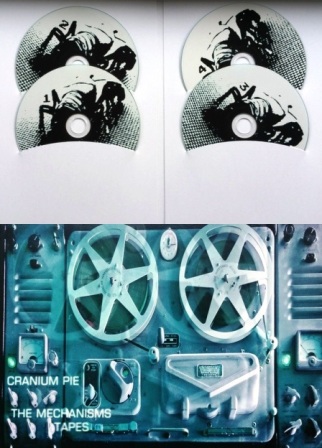 già lavorando ad un nuovo progetto?
già lavorando ad un nuovo progetto?
Rob – Credo che “The Mechanisms Tapes” è la nostra parte 3, la prossima tappa sarà “Tales from the Eleventh Dimension” (almeno questo è il piano).
Interessante! “The Mechanisms Tapes” è stato pubblicato alla fine del 2015 in download sul vostro sito Bandcamp poi su cassetta e CD in limited edition da Fruits de Mer. Quattro composizioni che durano lo stesso tempo, 44 minuti e 52 secondi da voi definite complessivamente come ‘three hours of improvisation, out-takes, intakes and late-night shed jams from Cranium Pie’s secret baking research station’. Un lavoro di assemblaggio notevole, ce ne parlate?
Rob – Sì l’assemblaggio è stata un’impresa imponente, e un enorme sollievo per averla completata, mi sono sentito abbastanza sopraffatto durante il montaggio, ma è anche stata una grande esperienza oltre ad essermi 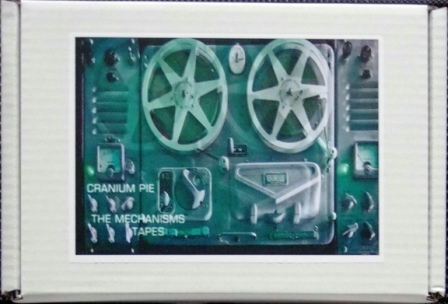 lentamente reso conto che forse questo progetto è stato più di un semplice out-take, ma in realtà la più genuina sensazione di ciò che probabilmente sono i Cranium Pie. E’ fondamentalmente un vasto assortimento di nostre vecchie jam sessions e tracce che ho trovato sul mio vecchio hard disk, ma anche perché sapevo proprio contenesse alcuni dei nostri lavori più speciali. 44:52, perché questo è il tempo massimo per lato di una cassetta C90 ed ovviamente è stato realizzato su doppia cassetta.
lentamente reso conto che forse questo progetto è stato più di un semplice out-take, ma in realtà la più genuina sensazione di ciò che probabilmente sono i Cranium Pie. E’ fondamentalmente un vasto assortimento di nostre vecchie jam sessions e tracce che ho trovato sul mio vecchio hard disk, ma anche perché sapevo proprio contenesse alcuni dei nostri lavori più speciali. 44:52, perché questo è il tempo massimo per lato di una cassetta C90 ed ovviamente è stato realizzato su doppia cassetta.
Svolgete un’attività live, vi vedremo in Italia?
Tim – Se hai mai avuto l’occasione di suonare dal vivo con una band composta da una vittima degli effetti dell’acido, un alcolista, un 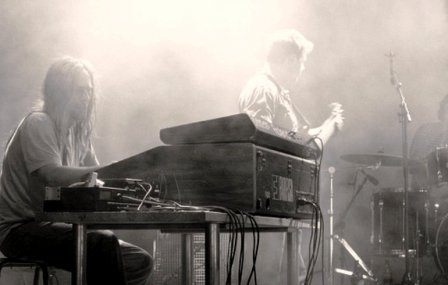 estroverso, un insonne, un agorafòbico, allora dovresti capire le complicazioni logistiche nel chiedere loro di muoversi insieme a 2 tonnellate di preziose attrezzature musicali d’epoca per 20 miglia in un furgone guidato da un amico psicopatico per poi trascorrere 2 ore a cercare di eliminare il ronzio da vecchi amplificatori a valvole e quindi il tecnico del suono lamentarsi per il rumore in un luogo che riecheggia come una piscina vuota. Poi uno degli organi va in corto circuito o un altoparlante Leslie esplode e diventi la band più rumorosa che un locale abbia mai avuto quindi le bariste si nascondono in cantina rifiutandosi di servire fino a quando non abbassiamo il volume! Poi per sentirsi dire alla fine della notte che il deejay è sempre più pagato di noi, allora potresti avere un’idea del perché abbiamo rinunciato molto presto a suonare dal vivo. La scena era solo un po’ ruffiana e non molti posti ci volevano, non con la nostra reputazione. Il Festival di Glastonbury fu un altro classico. Il tecnico del suono spense la chitarra di Dan perchè era ‘troppo rock n roll’ per così dire. Dan
estroverso, un insonne, un agorafòbico, allora dovresti capire le complicazioni logistiche nel chiedere loro di muoversi insieme a 2 tonnellate di preziose attrezzature musicali d’epoca per 20 miglia in un furgone guidato da un amico psicopatico per poi trascorrere 2 ore a cercare di eliminare il ronzio da vecchi amplificatori a valvole e quindi il tecnico del suono lamentarsi per il rumore in un luogo che riecheggia come una piscina vuota. Poi uno degli organi va in corto circuito o un altoparlante Leslie esplode e diventi la band più rumorosa che un locale abbia mai avuto quindi le bariste si nascondono in cantina rifiutandosi di servire fino a quando non abbassiamo il volume! Poi per sentirsi dire alla fine della notte che il deejay è sempre più pagato di noi, allora potresti avere un’idea del perché abbiamo rinunciato molto presto a suonare dal vivo. La scena era solo un po’ ruffiana e non molti posti ci volevano, non con la nostra reputazione. Il Festival di Glastonbury fu un altro classico. Il tecnico del suono spense la chitarra di Dan perchè era ‘troppo rock n roll’ per così dire. Dan 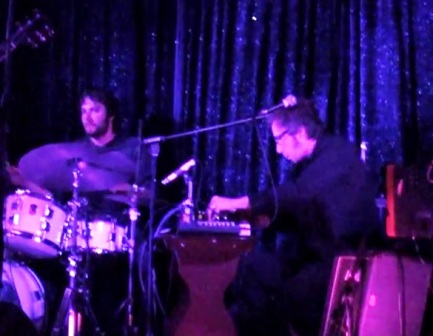 se ne andò infuriato e ritornò dopo pochi minuti per distruggere la sua chitarra facendola volare per tutto il palco. Passando in mezzo ai frammenti siamo riusciti a fuggire dal festival lasciando Dan sul palco. Mi ricordo che mi chiamò un paio di settimane più tardi. ‘Che hanno fatto alla nostra attrezzatura? Le mie chitarre fottute!’. ‘Mi chiedo come sia potuto succedere?’, Risposi. Quando ci restituirono la nostra attrezzatura fu complicato per noi ritornare a frequentarci. Quindi tutto il kit rimase impacchettato in studio. Fu una vera e propria conquista reimpostare e cablare tutto per tornare a lavorare di nuovo correttamente. Così i concerti restarono solo qualcosa di simile a un compito. Credo che nessuno di noi fosse davvero interessato a suonare dal vivo. Quello che volevamo era fare musica e jam session e i concerti si sono come intromessi. Suppongo che la vecchia idea di essere una rock star era qualcosa a cui qualcuno di noi credeva. Ma è stato un grosso sbaglio davvero. Comunque, tutto nacque dalla proposta dei Future Sound of London di partecipare al Green Man festival. Prima di allora eravamo solo io e Rob a pasticciare. Poi, all’improvviso, ci siamo sentiti sotto pressione per fare una vera band. Una volta imboccata questa strada siamo rimasti
se ne andò infuriato e ritornò dopo pochi minuti per distruggere la sua chitarra facendola volare per tutto il palco. Passando in mezzo ai frammenti siamo riusciti a fuggire dal festival lasciando Dan sul palco. Mi ricordo che mi chiamò un paio di settimane più tardi. ‘Che hanno fatto alla nostra attrezzatura? Le mie chitarre fottute!’. ‘Mi chiedo come sia potuto succedere?’, Risposi. Quando ci restituirono la nostra attrezzatura fu complicato per noi ritornare a frequentarci. Quindi tutto il kit rimase impacchettato in studio. Fu una vera e propria conquista reimpostare e cablare tutto per tornare a lavorare di nuovo correttamente. Così i concerti restarono solo qualcosa di simile a un compito. Credo che nessuno di noi fosse davvero interessato a suonare dal vivo. Quello che volevamo era fare musica e jam session e i concerti si sono come intromessi. Suppongo che la vecchia idea di essere una rock star era qualcosa a cui qualcuno di noi credeva. Ma è stato un grosso sbaglio davvero. Comunque, tutto nacque dalla proposta dei Future Sound of London di partecipare al Green Man festival. Prima di allora eravamo solo io e Rob a pasticciare. Poi, all’improvviso, ci siamo sentiti sotto pressione per fare una vera band. Una volta imboccata questa strada siamo rimasti 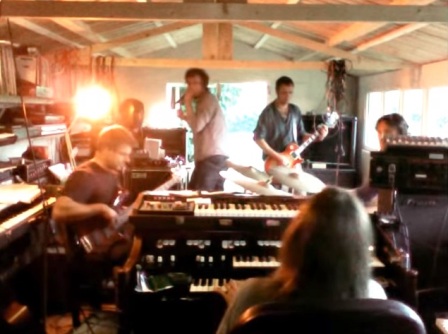 bloccati anche se alla fine ne valeva la pena. Miracolosamente siamo riusciti a pubblicare molto materiale anche su vinile grazie a Keith Jones di Fruits de Mer e a Rob che con perseveranza infinita ha mixato il tutto in qualcosa. E poi sì, potremmo venire a suonare in Italia se ci fossero delle proposte.
bloccati anche se alla fine ne valeva la pena. Miracolosamente siamo riusciti a pubblicare molto materiale anche su vinile grazie a Keith Jones di Fruits de Mer e a Rob che con perseveranza infinita ha mixato il tutto in qualcosa. E poi sì, potremmo venire a suonare in Italia se ci fossero delle proposte.
Rob – Oltre a ciò che ha detto Tim, penso che i Cranium Pie abbiano funzionato meglio per tutti noi come una forma di terapia lasciandoci sempre al massimo dopo le jam, i volumi erano così potenti che non ci sarebbe stata una singola cellula del nostro corpo che non veniva trasmutata ripetutamente ad ogni session. I concerti dal vivo hanno bisogno di molto lavoro e può essere stressante anche nel comportare un’inversione per tornare indietro da dove siamo venuti. Fuga dalla follia della vita, della società e superamento delle sue convenzioni. Cranium Pie significa evasione.
 DISCOGRAFIA
DISCOGRAFIA
ALBUM
Mechanisms Pt.1 (LP, Fruits de Mer + CD, Lunartica, 2011)
The Geometry Of Thistles (LP & CD, Lunartica, 2012)
(CD fake japanese edition, Fruits de Mer club members exclusive, 2016)
Mechanisms Part Two (2xLP, Fruits de Mer, 2015)
The Mechanisms Tapes (2x cassette & 4xCD, Fruits de Mer, 2015)
SINGOLI
Baby You’re A Rich Man / Madman Running Through The Fields (7″, Fruits de Mer, 2009)
Mothership / Rememberrr (7″, Bracken, 2010)
A Visit To Newport Hospital (by The Baking Research Station) / Queen Street Gang (7″, Fruits de Mer, 2012)
The One Not Me Not I (outtake di Mechanisms Pt.1, CDr, Fruits de Mer, 2014)
COMPILATION
A Monstrous Psychedelic Bubble Vol 1 – Cosmic Space Music (con ‘There It Is Part 2’, ‘Awakening Of The Birds’ e ‘Drying In The Sun‘, 2xCD, Platipus, 2008)
A Monstrous Psychedelic Bubble Vol 2 – Pagan Love Vibrations (con ‘Madman Running Through The Fields’, 2xCD, Platipus, 2009)
We Come Bearing Gifts (con ‘The Geometry Of Thistles’, cassette & CDr, Fruits de Mer, 2009)
Eddie Cochran Instrumentals (by Baking Research Station con ‘Jam Sand-Witch’, 7″ Fruits de Mer, 2010)
A Phase We’re Going Through (con ‘Little Wing’, LP Fruits de Mer, 2010)
A Phase We’ve Been Through (con ‘Run to Survive’, CDr Fruits de Mer, 2010)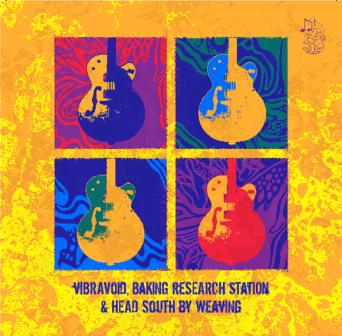
Roqueting Through Space (con ‘Blacksand’, LP Fruits de Mer, 2011)
Keep Off the Grass (con ‘Welcome To The Citidel’, 2xLP Fruits de Mer, 2011)
The White EP (con ‘The Continuing Story Of Bungalow Bll’, 2×7″ Fruits de Mer, 2012)
The Cartel Remixes (remixes by Cranium Pie’s Baking Research Centre di ‘Wasped’ e ‘1 000 000’, 2xLP Monstrous Bubble Records, 2014 )
ALTRO
Moonweevil (Rob Appleton) – A Peculiar Accumulation Of Particles (DL + CDr Friends Of The Fish, 2015)

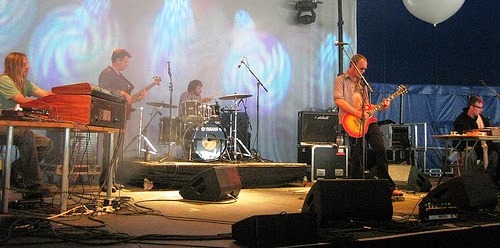
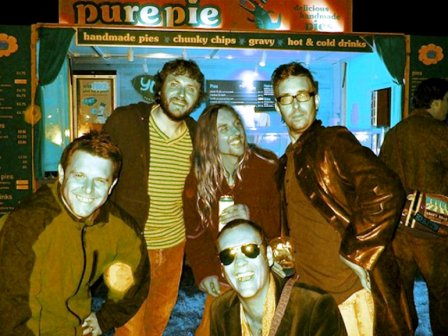

English translation
CRANIUM PIE
INTERSTELLAR OVERPIE
Plenirockium still on the trail of a magnificent band from our 2015 playlists to offer you this exclusive interview with Cranium Pie, Hertfordshire’s originating active since the middle of 2000 and among the most creative in the contemporary underground scene. Tim Bray (keyboards, vocals), Rob Appleton (keyboards), Julian ‘Smithy’ Smith (drums), Dan ‘Dendrix’ Herra (guitar) and Steve Meadows (bass) play a crazy rock astronomy and can also be followed upside down in the absence of gravity generated by stellar polyphony of space-psych-jazz-prog-folk confluences. A story to be told from the beginning in a playful conversation with the two keyboards magicians Tim Bray and Rob Appleton…
Tim: Cranium Pie came about originally as a name for a fictional band from the 70’s who’s tapes we were going to discover in a grandparents loft. We would then release the tapes on vinyl hailing the discovery of a really amazing band from the 70’s that no one had heard of. It was a spoof which got out of hand.
A friend of Smithy had already started the back history with a fake television series from the 60’s called ‘Charlie Why’ I think he was a paranormal detective. He had gone to some lengths writing characters, plot outlines, episode titles and synopsis and Rob and Smithy had set about recording the Theme tune and other tracks to accompany the series (‘Tears of a Clone’ was one of the titles that sticks in the mind).
This was all on the internet at some point, but it’s going back a bit. I can’t find it now. So, the soundtrack of the series was done by a fictional trio known as The Triplet. This was Rob, Smithy and one of their pals Jules. Robs fictional name in the fictional band in the fictional television series was Reg Craine. Somewhere along the lines Tim’s fictional name in a fictional group ( I can’t remember the tenuous link) from the same era was Mike Pye. They teamed up in reality and kept their fictional names to form the new project Cranium Pie and there it was. The planned non-existent band was formed and the tapes are still awaiting discovery in someones fictional grandfathers loft in Watford.
Rob: Yes – was an odd way to form a band. We’ve all been in other bands – Smithy and I have played together on and off for about 25 years, and have an almost psychic connection when it comes to jamming – never experienced that in the same way with anyone else. Dandrix and his guitars are well known in Bath – he must have jammed with (and no doubt kicked out of) dozens of bands – We were the only ones left brave enough to take him on – many people couldn’t believe we did – but somehow the music tamed him, or something (well, there were moments of relapse of course…usually in public). Tim and I were in an improv band (Spacejunk Triangle) way back, and Steve has been around in various guises for years too.
Are we stable? Considering all of the collective brain damage the band shares, we haven’t done badly.
(P) At the end of ’00 years some of your songs was published in the two opening volumes of the encyclopaedic project ‘A Monstrous Psychedelic Bubble’ by Amorphous Androgynous (aka The Future Sound of London): ‘Vol 1 – Cosmic Space Music’ and ‘Vol 2 – Pagan Love Vibrations’. Are them also your first recordings? How it originated the meeting with Brian Dougans and Garry Cobain and may have helped to promote Cranium Pie the presence in these compilations?
Rob: Yes the tracks on bubble 1 were from the geometry of thistles lp – our ‘madman running through the fields’ cover for Fruits de Mer records is on bubble 2.
I first met Gaz through myspace – (same with Keith from Fruits de Mer) – then in a non-cyber way at their monstrous bubble extravaganza at the Greenman festival which they invited us to open for – an 11 hour psych set which included Hawkwind, Amorphous Androgynous and Nick Nicely. That was this incarnation of the pie’s first ‘proper’ gig – we had a practice gig the week before in my local village pub – think they didn’t know what hit them, but they seemed to like it. I vaguely recall after the gig Tim doing running somersaults backstage across the grass in some sort of fit of something or other, then acting dead – think the security were most confused and not sure what to do – was too weird for them I think — Dan of course found the other bands riders and so we drank them pretty much dry – for some reason the greenman never asked us back the year after..not sure why.
The appearances on the Bubble lps may have helped promote us a bit, but then we always ended up scuttling off back to our subterranean hide-out, so it’s all ‘wurst’ in the end (that’s what they say here in Austria when it doesn’t matter – means ‘it’s all sausage’) – most of our lps are sold thanks to the tireless work of the grand fishmonger Keith at Fruits de Mer, and get snapped up by collectors on ebay.
(P) The cover of ‘Madman Running Through The Fields’ by Dantalian’s Chariots (also on the Vol. 2 of the above compilations) together with an instrumental version in ‘library music’ style of ‘Baby You’re A Rich Man’ by Beatles, is also in your debut 7″ single issued by Fruits de Mer in 2009 in a series of tributes to the 60s – 70s psych-prog-jazz-kraut-space-folk galaxy even now underway. It is also the beginning of your relationship with Fruits de Mer. How it originated this relationship and the choice to pay homage to those songs?
Tim: I think Smithy had come over to Robs studio for whatever reason wanting to do an ‘easy’ cover of ‘BYARM’ Rob recorded it in the Organarium. A unit he rented which was filled with lots of keyboards, piano’s, organs, mannequins, guitars, about 3 drum kits, numerous amps, silly hats, sofas, broken tv sets, well anything and everything.
So they just set about recording it that same evening, and I think Rob sent the youtube link to Keith (and Andy bracken) at FDM, via myspace. This was probably Keiths first encounter with us. He liked it and wanted more. Little did he know what he was letting himself in for. I wonder with hindsight whether he’d do it again.
(P) In 2010 comes out your second single “Mothership / Rememberrr” on Bracken, two original compositions for us amongst the top 7″ of the decade ’00. I think the last issue made by the label that had pioneered Fruits de Mer. Two ‘space bodies’ floating in a cosmos of keyboards and synthesizers where you develop your idea of progressive psychedelia, even as a future trend in expressing a music of research and contamination. What has led you to develop this research?
Rob: Not sure how to answer this – I guess many years of listening to good music has soaked into our psyches – certain elements from lps always lodge in my brain – like the mixture of acoustic guitar and synths in Floyds Animals lp – such a great album .
Smithy and I were collecting records for a long, long time, and have been sharing new discoveries for many years (since late teens).
A good friend Chris has recently been getting me into all sorts of rare prog and psych too – so it kind of seemed natural to fuse the styles together – I guess I had a vision of being able to make the kind of music I’d most want to hear.
Rememberrr was developed from the original stripped back version on the Geometry Lp.
(p) Curiosity: why the two more ‘r’ at the end of remeber?
Rob: We used to use delay on the vocals a lot – so it seemed to make sense to use delay in the title too
(P) “The Geometry of Thistles” comes out in 2012 (LP & CD) selfproduced on Lunartica but belongs to your beginnings as a band and from the internal notes testifies a period between 2006 and 2010. Tell us about this beautiful album in which prevail an acoustic component in the framework of enchanting psychedelic folk geometries, basically your ‘John Barleycorn’…
Tim: This was results of lots of discussions and me and Rob stood in fields in the Autumn sunshine as we built dry stone walls together. Eventually and occasionally we would do a recording. This was done outside, at the kitchen table anywhere really. It was a really playful psychedelia and came of no real desire to be anything in particular. This was the original sound with just me and Rob mucking about really. This was before FSOL got onto us and made us offers to play live. I would have loved to have kept this vibe going but we couldn’t work out how we could have done it on a stage at a festival. Thought we needed a bigger sound. This was when we recruited Dan and Steve. Smithy had some parts on GoT. Trawler man and Animals and Wood were his tracks. We didn’t have drums but Smithy is a great drummer so when the live plan unfolded Smithy was on drums and Rob keys and I was left to play the fool.
We tried to go back to the folky thing a few times but really that was the moment. We couldn’t really recapture the early innocence and magic.
Rob: Yes the early days of the pie were very different, and actually more experimental I think. Some inspirations for me included the Incredible String Band – Syd Barrett – drystone walling at Mr Fullers estate in Little Chalfield – Tim’s orange kitchen – a time of innocence with dark clouds on the horizon. I wasn’t very awake back then either (though of course I thought I was) – so I guess that would explain my part in the dreaminess of it all – a lot’s changed since then – so for me at least, I think that phase will remain forever in the past.
(P) 2011 is the year of your first album “Mechanisms Part 1”, always on Fruits de Mer, a project revealed by exciting acoustic-electric-electronic alchemies. Which ideas have brought you to conceive and develop this album?
Rob: Well musical influences might be artists like Arthur Brown- Floyd of course – Zappa – Canterbury Scene – all sorts really. The whole work was recorded in my old shed in the SW of England – many late nights jamming ideas, then months trying to decipher all the madness and make it into an album. No-one really knew how it would turn out, or what it even really was whilst it was going on – no track ever sounded the same each time we played it – always lots of improvisation went into our music.
Of course a lot of our sound comes down to the combination of all of our styles – for example Dan has this really edgy, aggresive yet soulful way of playing guitar – it’s unique to him and incredible – really hits the spot – I think he’s a total genius actually. Smithy’s drumming is often inspired by British Jazz from the early 70s, like Nucleus – Tim is inspired by…well…em…best not go there…but when its all mixed together it becomes this amalgam that is ‘us’ I suppose.
(P) “Mechanisms Part 1” is a big melting pot where space rock, jazz, psychedelia and progressive swirling at 360° triggered by a corrosive and playful thought, a search of the paradoxical, a critical attention to the society on environmental, technological and alienation issues, producing points for reflection. Mechanisms, machines and strange creatures similar to shellfish, very interesting, could you talk us about it?
Tim: We had this partial inkling at the time that things were speeding up to the end of the world. The Mayan calendar was drawing to a close, there were tales of a Polar shift, the Deep horizon oil leak was briefly in the news and we had the feeling that we were not being told the truth about anything. Well we weren’t being told the truth.
If felt that our world was heading to its end and what would it be like to be the last band left to tell the story or the final chapter of our civilisation.
Also around the same time mass looting and riots were breaking out in London and it was a time of real civil unrest right across England. These were idiots just looting shitty shops to steal clothes and electrical goods. But it was scary. Imagine if these mobs were hungry and looting houses in search of basics. It felt like the start of the end days. Also having this bonkers theme that Rob had come up with (partly due to what he saw in the photogenics of crayfish and their abundance in a nearby stream). They are American signal crayfish and have decimated the native European freshwater crayfish (Austropotamobius pallipes). Made it easier for us to make themes and stories to follow in a sort of timeline. Only the story constantly changed as we went along and became even more and more complicated with numerous twists which left us all completely bewildered as to what the actual story was about. It was lots of fun recording though having this mad srtory which could go wherever we wanted it to and if an idea was stupid or too mad but we found it funny we would just include it.
We all really like the bizarre and strange and had similar senses of humour so a serious piece of narrative or music will always be done with a bit of something which made us laugh at the time, maybe little in jokes would creep in which in our childish minds we could snigger about how we managed to sneak in a reference about shit or recording the sublimal fart in the background that only we would get or know was there.
It was all very silly.
Rob: There was definitely a serious element (if you choose to look for it) behind the mechanisms lps – it is of course masked with humour though, as if not, it’d all be just too heavy – I think humour is possibly the most valuable tool that we’ll need if the shit really hits the fan. The albums are ultimately a reaction to societies shit and madness – it’s all mad – all of it – the mechanisms try to defeat us – I suppose the lps message would be for us to wake up and not buy into this voluntary conformity that most humans suffer from….I guess the ridiculousness of the mechanisms concept is a reflection of the ridiculousness of how we’ve formed our world, and how we constrain our lives through fear and lack of imagination….or something. It’s like we’re all addicted to normality and can’t break the habit, always cross-referencing with those left and right of us, to make sure we don’t stick out from them. It’s all so dull and predictable. I think this is what we’re trying to escape from with our music
(P) It’s also interesting how your musical research develop a ‘mechanical’ science fiction: the voices are often treated and de-humanized and the transmission of your sound is like a motion featuring levels of power and speed in complex rhythms on which dialogue guitar and keyboards. Moreover keyboards are also relevant in terms of the mechanisms that generate sounds, what type of electronic equipment do you play? Do you work also on the sampling and tapes manipulation?
Tim: From the point of view of the vocals. This was always a bit of a tricky area. None of us had an especially powerful or ‘in tune’ singing voice. Rob had various experimental tricks for getting round this. Often vocals recorded multiple times forming the ‘Pie Choir’ or sending one half through ring modulators, delays or distortion effects. Just playing around with the sounds really trying to find something we might not have expected and in that moment when you do something just to see and it works well. The happy accident is a common occurrence in the bands recording technique. But yes keeping on the theme with the mechanoids and the sounds which we thought might be the sounds the crayfish would make if they were to be able to generate some audible sound what would it sound like?
Rob: Most of the keys are old analogue jobbies – like the Logan string synth, roland juno60 etc – I also use a Hammond m100 and fender rhodes. I did sample a friends mellotron and minimoog to tape, and used some of these sounds in places too. One of my favourite samples was on the Geometry Lp – at the beginning of Awakening of the Birds. Tim had a couple of friends round – and one of them suggested flapping books for the bird’s wings – so we all lined up with a book in each hand at floor level, then flapped the books up into the air to simulate the birds flying off. Having that kind of creative freedom in the music – where anything goes – seems to make sense to us.
(P) Rob, speaking of electronic music, on your Bandcamp site you published a very kosmische project by Moonweevil, dated 2006 and entitled “A Peculiar Accumulation Of Particles” described as ‘rural Electronica Soundtracks and Train Journey’. Could you talk us about it?
Rob: Well that was a sort of stream of un-conscious electronica thingy I did pre-pie, kind of open to interpretation really. I wanted to create some non-urban, un-trendy electronica..it takes you into a sort of dreamstate – good with headphones when you’re observing man’s creations through the window of a train or something. Am currently working on a new moonweevil lp (I think)…
(P) By the way of Cranium Pie extra projects, in 2011 Fruits de Mer releases the compilations ‘Roqueting Through Space’ and ‘Keep off the Grass’ where you appear with the name of Cranium Pie’s Baking Research Station to reinterpret ‘Blacksand’ by space rock pioneers Brainticket and ‘Welcome to the Citadel’ by Mark Brierley (also the title of his first album) in which you develop a psychedelic folk basis in 10 minutes of interstellar space jazz-prog. Recently also in another Amorphous Androgynous project “The Cartel Remixes”, to work with alternative versions of ‘The Cartel’, a psychedelic study on 70s blaxploitation movie soundtracks. Cranium Pie’s Baking Research Station may have a future? From the notes on your records Baking Research Station is also often mentioned as your own studio. Could you talk us about it?
Rob: The Baking Research Station (named after a real baking research station opposite my old primary school in Chorleywood) was the name for my old shed studio – I currently have no shed as am now settled in the Alps – but am working on it…hoping for a Summer Pie reuinion here in Austria. It’s also the name for pie related side projects that I work on – more production based tracks than band recordings really.
(P) In 2012, Cranium Pie and The Baking Research Station are still together on a 7-inch with covers of “A Visit To Newport Hospital / Queen Street Gang” respectively by Egg and Arzachel, legendary bands with the great keyboard player Dave Stewart, and your personal tribute to the music of Canterbury (think also about the sleeve of the first Soft Machine with the mechanisms and their pataphysical similitudes with your ideas that merge into one the nonsense, the irony and the absurd). It seems almost a constant inspiration in which shines through your fascination for this essential scene that can still influence generations of musicians. Do you agree?
Tim: For me it was an excuse to dress up as Penny Handy my female split personality nemesis and enact a séance. We spent ages trying to perfect the effect of ectoplasm pouring out of my mouth with lengths of white cotton for the video. Its on Youtube. The ectoplasm didn’t make the cut.
Rob: Shit – don’t remind me of that evening filming the séance – was one of the funniest yet most disturbing nights of my life – Tim has a special talent for funny yet disturbing – he should have his own tv show. Someday I’ll dig out the video out-takes and post them on youtube – just need a few more years to process that fateful evening before I can revisit the footage.
The Canterbury scene – Yes for sure – there’s something very special about that scene – the musicians were just incredible – a fantastic prog,psych, jazz fusion – the more I think about it the more depressing it is to think that maybe there will never be another period of music like the late 60s / early 70s – there was so much talent and good taste around back then it’s unbelievable – I think many of the best bands were in it for different reasons back then – maybe that’s part of the secret to their magic.
(P) The third album is a very recent history, released by Fruits de Mer last March: “Mechanisms Part Two”, the second chapter in the world of mechanisms presented in a double vinyl: disk 1 ‘We are not Human’ and disk 2 ‘We are not Machines’. A modern manifesto of space rock already in our top albums of 2015!! The liner notes reveal the new sci-fi setting where your creatures are moving between post apocalyptic scenarios and time machines (I don’t know why but it’s something that makes me think about the masterpiece of Terry Gilliam ’12 Monkeys’). Three years to create the new ‘mechanisms’, could you tell us about the artistic path of this gestation?
Tim: Its all part of a weird dream looking back. It seemed like the impossible. So much was going on with the band. Dan was consistently off the rails, Steve was pretty aloof. He was busy putting on gigs in Spiegeltents and trying to keep his own life on track. Smithy had pretty much had enough of the whole thing. He was doing lots of driving to rehearsals, trying to give up smoking, trying to start his new record shop (which he succeeded in doing – name drop- Second Scene, your one stop shop for vinyl!) and I think the whole thing ended up frying his brain and to be honest getting us all in one place at the same time was getting harder. I was recruited back on drums after we auditioned a few other drummers and Rob was making plans and eventually did move to Austria.
The recordings were getting more and more sporadic and random and it just seemed to be an impossibility that any of it could ever come together. Just listening to the mechanisms tapes you get the impression how there was so much stuff recorded but Robs somewhat random filing technique meant if anything could be found it was a miracle. Of course there must have been a method to his system as eventually he did it. He moved to Austria and somehow unpicked the never ending tangle and created an end product we were not only amazed by but proud of. It’s the classic tale. Completely unlike the recording of the Beatles White album I suspect but I have a feeling there were some similarities, and no there was no Yoko.
Rob: It was an epic task actually — Tim’s summed it up well, but to add a little – it started off with good intentions – writing tracks and getting Dandrix to come over and do his guitar parts, or Smithy to lay down the drums etc…then it sort of ended up with shitloads of jamming but never actually finishing – then I moved abroad…then I spent a year polishing the almighty mound of turd into something album shaped – only the turd was so big it had to be a double…and then there was still more turd left over so I had to make a triple – the mechanisms tapes – which actually contains some of our best material – a little rough round the edges, but gives a real idea of what we were about – like a fly-in-the-wall to our jams. Some of our jams (always the ones I forgot to record) were I think quite incredible – sometimes we couldn’t believe what was going on – there was a real magic in that shed — especially with the actual sound, which was kind of fudgey and vibey. Now my mission is to build a new one in the mountains – then drag the degenerates across the channel somehow and get playing again.
(P) Mechanisms as part of articulated systems for the build of automatic machines able to produce complex movements and fulfill human functions: robots, a very topical theme often anticipated by the great science fiction writers as Isaac Asimov and Philip K. Dick. Men and machines, artificial intelligence, illusion of freedom, deskilled workers, weapons and de-evolution. Once again the humans in an attempt to improve their lives threatens to complicate. And in your history, humanity is already extinct: no hope then?
Tim: Possibly not. But I think the crayfish end up building the hummunculus and there is hope. It worked and this disfigured abomination vaguely resembling a human form goes on to help them defeat the mechanisms. He discovers the blinking eye which I have a feeling was a vagabond who was peering in through a hole in the wall. He was having a super time watching the whole end of civilization thing going on like watching the news. Powerless and knowing in a minute some other crap will be put on the screen. The vagabond was blissfully residing in the 11th Dimension. This is a place where we all end up. The next album possibly. We are hoping to do it remotely. Rob will make the head send it to me. I’ll do the body, send it back to Rob who will do the legs and send it back to me to add the feet. It might work. We haven’t really started it yet.
Rob: There’s always hope – it’s just usually it seems that us humans don’t do anything about it until it’s too late,w e all suffer from our own individual and collective minor madnesses, whether its from being obsessed with collecting records (even though all the music is on the net) to thinking its ok to kill civilians as a drone pilot, because it’s all on a computer screen and you were told to do it by someone higher up than you. I guess part of the message is to allow people to subconsciously draw comparisons with our daft concepts and music and their own lives – maybe its not so unrelated after all. I sometimes find it funny that a lot of people who listen to our music are old enough to know better, and seem to have quite successful careers – almost as if they use our music for escapist therapy in the same way we do.
(P) Will also come the ‘Mechanisms Part 3’ or are you already working on something different?
Rob: I think ‘The Mechanisms Tapes’ is our part 3 – next stop, ‘Tales from the Eleventh Dimension’ (least that’s the plan).
16) Interesting! “The Mechanisms Tapes” has been published at the end of 2015 on your Bandcamp site as a download then on limited edition cassette and CD by Fruits de Mer. Four compositions that last the same time: 44 minutes and 52 seconds, complessively defined as ‘three hours of improvisation, out-takes, intakes and late-night jams shed from Cranium Pie’s secret baking research station’. A remarkable assembly operation, could you tell us about it?
Rob: Yes the assembly was a massive undertaking – and a huge relief to get finished – felt quite overwhelmed when compiling and editing this, but also it was a great experience as I slowly started to realise that maybe this project was more than just out-takes, but actually probably the most genuine impression of what the pie are about. It’s basically a huge assortment of our old jams and bits and bobs that I found on my old hard drives which I wanted to collate before my hard drives break, but also because I knew its some of our most special work. 44:52 because thats the max time roughly for one side of a C90 cassette (as of course it came out on double cassette tape too).
(P) What about your live activity, hoping to see you play in Italy!!
Tim: If you’ve ever had to perform live with a band made up of sketchy acid casualty, alcoholic, extroverted, insomniac, agoraphobics then you would understand the logistical complications in asking them to move 2 tonnes worth of vintage musical equipment 20 miles in a van driven by a psychopathic friend to then spend 2 hours trying to eliminate the ‘hum’ from old valve amplifiers and then the sound man complaining about the noise in a venue which echoes like a swimming pool. Then one of the organs short circuit or a leslie speaker explodes and being the loudest band a venue has ever had the barmaids hide in the cellar refusing to serve anyone until we turn down. Then to be told at the end of the night by a bloke dressed and dancing like Austin Powers in a room full of punters dressed like go-go dancers that the deejay is getting paid more money than us then you might get an idea as to why we gave up the live thing pretty early on. The scene was just a bit cringey and not many places would book us. Not with our reputation.
Glastonbury festival was another classic we stayed up all night having fun. When it came to the gig the next day we were all either still hammered or in a poor state of recovery. The sound man just turned off Dan’s guitar as he was being a bit ‘too rock n roll’ shall we say. Dan stormed off and returned a few minutes later to smash up his guitar. Wanging it all over the stage. We got through it somehow and then manged to escape the festival leaving Dan behind. I remember him calling me up a few weeks later. ‘I don’t know what they did to our gear? My guitars fucked.’ ‘I wonder how that happened?’ I replied.
The rehearsals leading up to live shows were pretty tough going. By the time we got round to doing the gig and getting all of the kit back into the studio at 2am to carry on drinking it was pretty hard for us to face one another again for a while. So all the kit would remain packed away or dumped in the studio. It was a real mission to get everything set up and wired in and working properly again. So the gigs were just a bit of a chore. None of us really got much out of it I don’t think. What we wanted to do was make music and jam and the gigs got in the way. I suppose the old idea of being a rock star was something some of the band were into. But it was a load of bollocks really.
The whole live thing came about from the FSOL boys booking us for a gig at Green Man festival anyway. Before that it was just me and Rob messing about. Then suddenly we felt pressured into making a band out of it. Which once we were channelled down that route we were stuck with it.
It was worth it though in the end. Miraculously we managed to get loads of material released onto vinyl thanks to Keith at FDM and Robs un-ending perseverance mixing the whole thing into something.
So, yes we could come and play in Italy. If you can sort the tour out.
Rob: What Tim said, I also think the Pie worked best for us all as a form of therapy – everyone always left on a high after the jamming – the volumes were always so loud that there wouldn’t have been a single cell in our bodies that hadn’t been transmutated a hundred thousand times or more each session – live gigs need lots of work and can be stressful as Tim’s mentioned – the Pie is about escapism I suppose – escape from the madness of life, society and its conventions – I guess gigging invloves turning round and going back the way we came – there will inevitably be consequences…
Hi, great interview , i love this band . the main group photo at the beginning is from 23rd August 2009 Greenman festival in Wales , looks very much like the ones i took that have posted on flickr . am very pleased that they have been useful after all these years. have bought all their records too. i should not really say this but did get a rather good audio recording of that concert as well as taking the photographs
hey john – message us on faecebook could you – would love to hear the recording – maybe we could put out a bootleg – not sure tho – my memories of the gig was that it was a bit sketchy:)
rob from the pie
ciao john, thanks a lot – it’s nice to share your pictures of the festival and the love for the pie – in the close-up shot we can see rob play the roland juno 60 synth (on a farfisa organ) he mentioned in the interview
it was interesting also to discover and enjoy the whole set: https://www.flickr.com/search/?user_id=79197704%40N00&view_all=1&text=cranium%20pie
giampiero